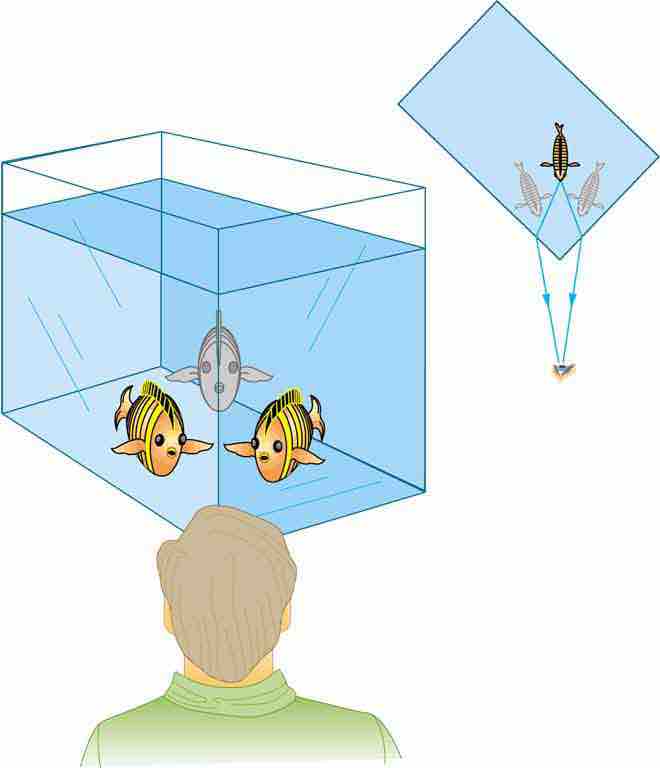It is easy to notice some odd things when looking into a fish tank. For example, you may see the same fish appearing to be in two different places. This is because light coming from the fish to us changes direction when it leaves the tank, and in this case, it can travel two different paths to get to our eyes. The changing of a light ray's direction (loosely called bending) when it passes through variations in matter is called refraction. Refraction is responsible for a tremendous range of optical phenomena, from the action of lenses to voice transmission through optical fibers.

Law of Refraction
Looking at the fish tank as shown, we can see the same fish in two different locations, because light changes directions when it passes from water to air. In this case, the light can reach the observer by two different paths, and so the fish seems to be in two different places. This bending of light is called refraction and is responsible for many optical phenomena.
Refraction: The changing of a light ray's direction (loosely called bending) when it passes through variations in matter is called refraction.
SPEED OF LIGHT
The speed of light c not only affects refraction, it is one of the central concepts of Einstein's theory of relativity. The speed of light varies in a precise manner with the material it traverses. It makes connections between space and time and alters our expectations that all observers measure the same time for the same event, for example. The speed of light is so important that its value in a vacuum is one of the most fundamental constants in nature as well as being one of the four fundamental SI units.
Why does light change direction when passing from one material (medium) to another? It is because light changes speed when going from one material to another.
Law of Refraction
A ray of light changes direction when it passes from one medium to another. As before, the angles are measured relative to a perpendicular to the surface at the point where the light ray crosses it. The change in direction of the light ray depends on how the speed of light changes. The change in the speed of light is related to the indices of refraction of the media involved. In mediums that have a greater index of refraction the speed of light is less. Imagine moving your hand through the air and then moving it through a body of water. It is more difficult to move your hand through the water, and thus your hand slows down if you are applying the same amount of force. Similarly, light travels slower when moving through mediums that have higher indices of refraction.
The amount that a light ray changes its direction depends both on the incident angle and the amount that the speed changes. For a ray at a given incident angle, a large change in speed causes a large change in direction, and thus a large change in angle. The exact mathematical relationship is the law of refraction, or "Snell's Law," which is stated in equation form as:
n1sinθ1 = n2sinθ2
Here n1 and n2 are the indices of refraction for medium 1 and 2, and θ1 and θ2 are the angles between the rays and the perpendicular in medium 1 and 2. The incoming ray is called the incident ray and the outgoing ray the refracted ray, and the associated angles the incident angle and the refracted angle. The law of refraction is also called Snell's law after the Dutch mathematician Willebrord Snell, who discovered it in 1621. Snell's experiments showed that the law of refraction was obeyed and that a characteristic index of refraction n could be assigned to a given medium.